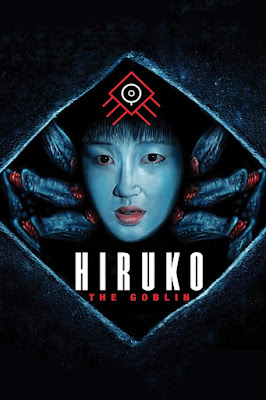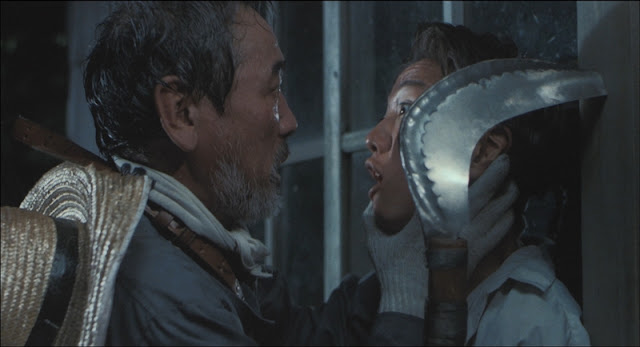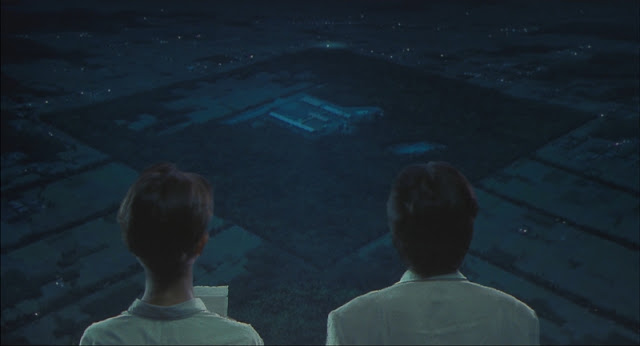(1991) Written and directed by Shin'ya Tsukamoto; Story by Koji Tsutsumi; Based on the manga by Daijirô Morohoshi; Starring: Kenji Sawada, Masaki Kudou, Hideo Murota, Naoto Takenaka, Megumi Ueno and Chika Asamoto; Available on Blu-ray and DVD
Rating: ***½
“…Light and darkness are the fundamental themes for all of
my films. There’s not much darkness in my world right now. Everywhere I go has
lights, so it’s getting harder for ghosts and monsters to hide. When I was
little, there were more dark spaces, even in Tokyo the corners of the room
would be dark, and you feel like you might see a ghost there… I miss those
times, and I wish I could live in those times. When I thought about ‘dark
space,’ I couldn’t think of anywhere in Tokyo. But in (the) countryside,
there’s still dark places, where monsters would hide. That’s why Hiruko
takes place in a small village. And the school at night is very scary.” –
Shin'ya Tsukamoto (excerpt from 2000 interview)
Ah…summertime. A time to relax in the sun, hang out with your friends, and fight demons. Writer/director Shin'ya Tsukamoto’s follow-up to Tetsuo: The Iron Man (1989) changes the setting/theme from urban cyberpunk to rural horror, where the peace and quiet is merely a prelude to the chaos that follows. Hiruko the Goblin (aka: Yôkai hantâ: Hiruko) seems almost conventional in comparison to its predecessor, but that’s selling it far too short. Hiruko is full of surreal imagery, frenetic pacing, and a pair of unlikely protagonists. Based on the “Black Investigator” and “Red Lips” stories from Daijirô Morohoshi’s Yokai Hunter series, Tsukamoto’s relatively big-budget second film seems almost lavish in contrast to the independently produced Tetsuo. The movie was filmed at Toho Studios,*/** and on location in the Japanese countryside (Toyoma prefecture), with a combination of veteran and novice crewmembers.
* Fun Fact #1: The pond used for the floating face scene (you’ll know it when you see it) was the same pool used for Godzilla.
** Fun Fact #2: Hiruko was filmed adjacent to the
area where Akira Kurosawa was simultaneously shooting Rhapsody in August.
Hiruko opens with a bucolic scene of high school student Tsukishima Reiko (Megumi Ueno) riding her bike on a country road. It’s a deceptive moment of calm, however, before the tawagato hits the fan. She joins her teacher Takashi Yabe (Naoto Takenaka) in an archaeological site near the school, where they’re promptly overwhelmed by an unseen terror. Their sudden disappearance prompts Yabe’s son Masao (Masaki Kudou) and his buddies to investigate the school grounds. When his friends succumb to the same terrible fate as Reiko and Yabe, Masao is forced to team up with his bumbling uncle Hieda Reijirou (Kenji Sawada).* They soon discover they’re in over their heads (quite literally), with an evil spirit named Hiruko with a nasty penchant for decapitations. Somehow, they must find a way to stop the ancient demon before he and his minions open a portal to hell and immerse the world in eternal darkness.
* Fun Fact #3: Sawada rose to fame as a big music star in
the ‘60s, before he caught the acting bug. He has appeared in several films,
including The Man Who Stole the Sun (1979) and Takashi Miike’s bonkers
but loveable The Happiness of the Katakuris (2001).
Kenji Sawada amuses as Reijirou, a discredited archaeologist (who wants to be Indiana Jones, but he’s more like Abbott & Costello, combined) who’s convinced that a hive of goblins resides directly beneath a local high school. His initially skeptical nephew seems inextricably linked to the supernatural goings-on, with a strange affliction that causes him to run extremely hot, and break out in huge boils on his back that resemble stone faces. Unfortunately for Reijirou and Masao their actions are further thwarted by the irascible school caretaker Watanabe (Hideo Murota, in a delightfully quirky performance), who roams the grounds on his own mission to combat the demon scourge. Watanabe straddles the line between friend and foe – we’re never quite sure if he regards them as friends, foes, or collateral losses.
Is or isn’t Hiruko a Yokai? Based on a 2021 interview with Tsukamoto, signs point to no. While he didn’t precisely commit to labeling Hiruko, he alluded to something more ancient – a throwback from Japan’s ancient mythological origins.* In the film it’s a nightmarish being that lives by decapitating its victims and taking on their appearance (In one simultaneously ethereal and horrifying scene, we see Reiko’s face floating in a pond, singing a siren song, before it walks out on a hideous set of crab legs). In the context of the film, a more accurate interpretation would probably be a demon.
* Fun Fact #4: The mythology implies something far less
sinister than the goblin depicted in the film. Hiruko (roughly translated as
“leech child”) was the deformed offspring of the gods Izanagi and Izanami, cast
adrift into the ocean. The child was rescued by the Ainu people of Hokkaido,
where he assumed his final form, as the benevolent god Ebisu.
Hiruko’s imagery recalls several American genre films from the time. Reijirou’s homemade goblin-hunting gadgets resemble something out of Ghostbusters. Hiruko, with its crab/spider-like appearance, immediately evokes comparison to John Carpenter’s The Thing (although Tsukamoto denied that the film was a conscious influence). The way Hiruko attaches itself to its victims is not unlike the facehugger in Alien, and the POV shots of Hiruko racing through the school corridors are an obvious homage to similar shots in the Evil Dead movies. Likewise, a huge silvery tentacle with a face recalls the “water weenie” from James Cameron’s The Abyss. The visual call-backs are not restricted to American movies, but Japanese cinema as well, as noted by author Tom Mes (in his Blu-ray commentary). One notable sequence was clearly inspired by Nobuo Nakagawa’s Edo-period film, Ghost Story of Kasane Swamp (aka: Kaidan Kasane-ga-fuchi), while numerous images are likely homages to the cinematic adaptations of Lafcadio Hearn’s works.
Hiruko the Goblin owes much to the American genre films that served as inspiration, but it’s much more than mere imitation, weaving a thread of Japanese folklore throughout. While the stakes are high, it never takes itself too seriously. There’s a playful mix of gore-drenched horror with slapstick comedy that wouldn’t be out of place in an early Sam Raimi or Peter Jackson movie. As Tsukamoto noted, it’s not an anomalous entry in his filmography, as some fans and critics might attest, but much closer in spirit to the sort of no-budget short films he was making prior to Tetsuo: The Iron Man. Although Hiruko wasn’t a commercial success, like so many other genre films, it’s stood the test of time to become a cult favorite. Here's hoping that Tsukamoto revisits this fun horror hybrid style someday.
Sources for this article: Mondo Macabro Blu-ray commentary
by Tom Mes; 2000 and 2021 interviews with Shin'ya Tsukamoto, Mythopedia entry
on Ebisu, by Gregory Wright








Excellent review of a film I've never heard of, barry!
ReplyDeleteThe idea of a face floating in the water and then emerging on crab legs sounds both fascinating and horrifying!
Plus, I love the Godzilla pond connection!
Thanks, John! I would describe this movie as nightmarishly playful. I hope you get a chance to see it. :)
DeleteI was hearing the finale from the William Tell Overture in my head as I read this--all calm and tranquil, and then the storm. :-)
ReplyDeleteLOL! Now I'm going to be hearing this play in my head. :)
Delete